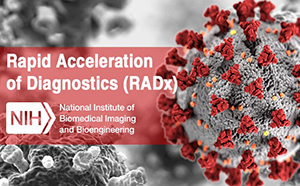Drugs and other treatments can be quite effective at killing cancer cells, but many fall short as they struggle to penetrate deep into solid tumors due to physical barriers within the tissue. But in a recent study described in ACS NanoResearchers may have found a way to get them through.
A team of bioengineers at the University of Pennsylvania transported therapeutic nanoparticles, with magnetic cores, deep into tumors by pulling them with an external magnetic device. Working on a mouse model triple negative breast cancerThe researchers used their approach to slow tumor growth much more than treatment with nanoparticles not exposed to a magnetic field.
“The results are encouraging, especially since there are not many effective treatments for triple-negative breast cancer,” said Tatjana Atanasijevic, Ph.D., director of scientific programs at the Division of Applied Science and Technology at the National Institute of Biomedical Imaging and Bioengineering (NIBIB). “These magnetic particles are excellent drug carriers and imaging facilitators and can now also break a physical blockage that previously seemed impenetrable.”
Chemotherapy and other common forms of cancer treatment indiscriminately attack rapidly dividing cells, sometimes causing serious side effects in otherwise healthy tissues. A long-standing goal of cancer researchers has been to develop strategies that specifically target tumors. One such strategy takes advantage of leaks from abnormally formed blood vessels in tumors. Using nanomaterials, researchers can deliver drugs in packets that are large enough to stay outside healthy tissues with intact vasculature, but still small enough to pass through gaps found in tumor vessels.
But while these drug carriers can technically enter tumor tissue, they usually don’t go very far.
“By going this route, you avoid some uptake from normal tissue, but the challenge is that the nanoparticles are much larger than the drugs alone, so they don’t penetrate the tumor as much. They just get stuck around the blood vessels,” said Andrew Tsourkas, Ph.D., professor of bioengineering at the University of Pennsylvania and co-senior author of the study.
To help the therapy penetrate deeper into the dense tissue inside tumors, Tsourkas and his colleagues attempted to employ the attractive force of magnetism, which is already used routinely in the clinic. With this approach, nanoparticles would passively escape from the gaps in a tumor’s blood vessels and then a magnetic field could distribute them more evenly throughout the mass.
In a past study The researchers designed a two-magnet system to attract magnetic iron oxide nanoparticles deeper into mouse tumors. They gained some ground with this approach, propelling the particles further, but the process required eight hours of exposure to the magnetic field. And yet, most of the tumor remained intact as the system was only able to pull in a single direction.
Based on this research, the team built a cylindrical system of eight magnets, resembling a miniature magnetic resonance imaging (MRI) machine, that could generate a stronger magnetic field, exerting an outward attraction from the center of its aperture. Their goal was to find out if the device could achieve better particle penetration and destroy more tumor cells. The authors coated clusters of magnetic nanoparticles with a chemical used in cancer treatments called chlorine e6or Ce6, which, when hit by certain types of light, produces reactive molecules, known as free radicals, that are toxic to nearby cells.
The researchers intravenously injected these clusters of coated nanoparticles into mice that had triple-negative breast tumors near the surface of their abdomen and then placed the animals’ midsections on their magnetic device. After three hours, the team used MRI to confirm that the particles, whose magnetic properties make them highly visible with this type of imaging, accumulated and spread in the tumors much more than in a group where no magnetic field was applied.
The researchers then shined red lasers on the animals’ skin and breast tumors, activating the Ce6 coatings.
For comparison, another group of mice was treated with the two-magnet device developed above, while an additional group was not exposed to any magnetic field.
The authors followed the growth of the tumors for 16 days and then, at the end of the experiment, placed the tumors under a microscope to look for the particles. They reported that tumors treated with the new system contained 3.7 times more particles, which penetrated 3.5 times deeper, compared to tumors treated with the previous device, ultimately significantly slowing their growth compared to all other groups.
Having achieved their goal of improving therapeutic coverage in tumors, the researchers are now working to learn whether they can maintain or improve performance by building larger versions of the magnetic system that are more suitable for humans.
The team also plans to address other clinical challenges, where physical barriers in the body make it difficult to access drug targets. One application could be to use the technology to transport therapies. through cartilage to treat osteoarthritis.
“There are many applications where poor drug penetration is a major obstacle, from cancer to joint diseases and various lung pathologies. We envision that one day this technology could be widely useful,” Tsourkas said.
This study was supported in part by grants from NIBIB (R01EB029238 and R01EB028858) and the National Institute of Arthritis and Musculoskeletal and Skin Diseases (R01AR080820).
This prominent scientist describes a basic research finding. Basic research increases our understanding of human behavior and biology, which is critical to promoting new and better ways to prevent, diagnose, and treat diseases. Science is an unpredictable and incremental process: each research advance builds on past discoveries, often in unexpected ways. Most clinical advances would not be possible without knowledge of fundamental basic research.
Study reference: Bian Jang et al. Enhanced accumulation and penetration of magnetic nanoclusters into tumors using an 8-magnet Halbach array leads to improved cancer treatment ACS Nano (2025). DOI: https://doi.org/10.1021/acsnano.4c16600



